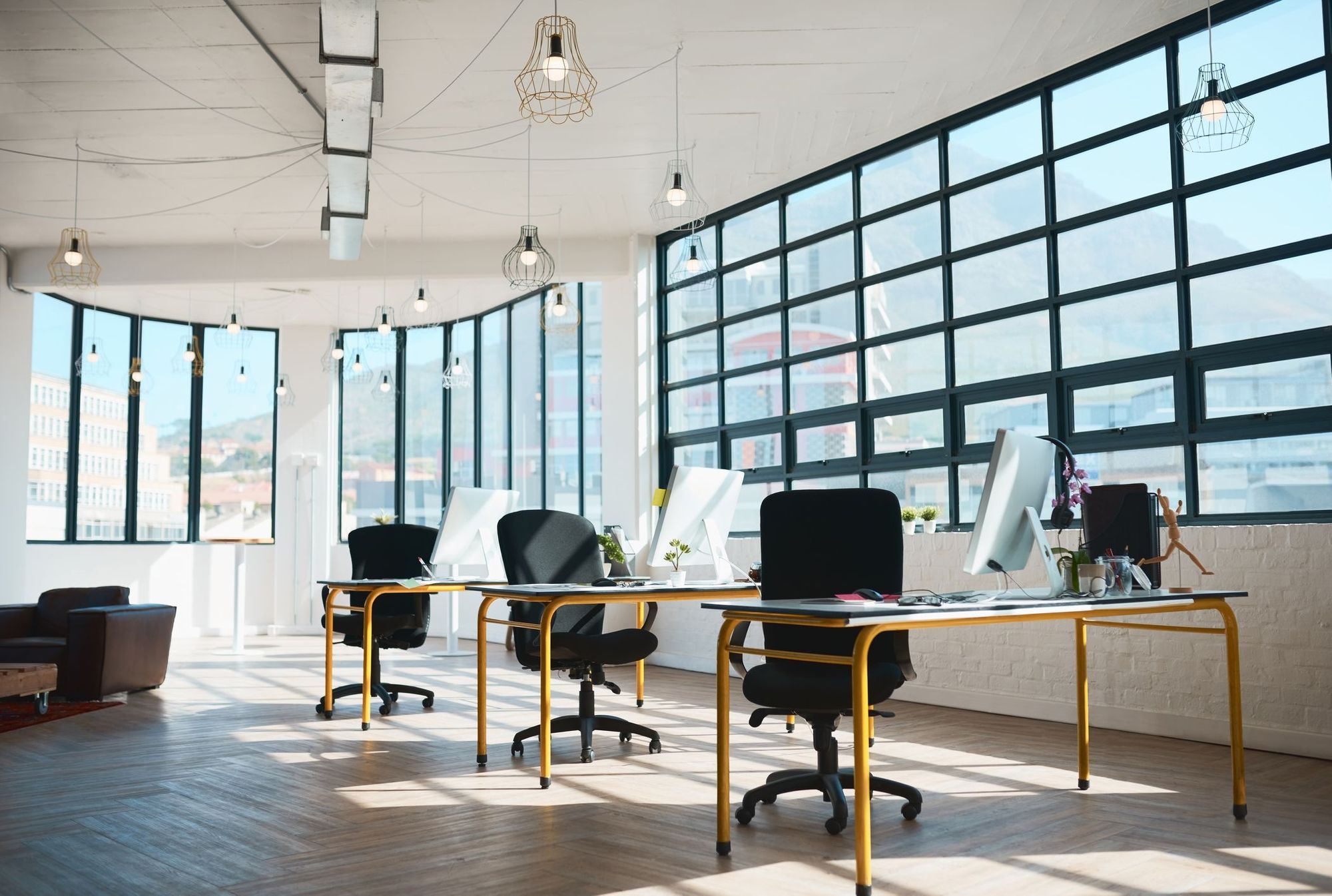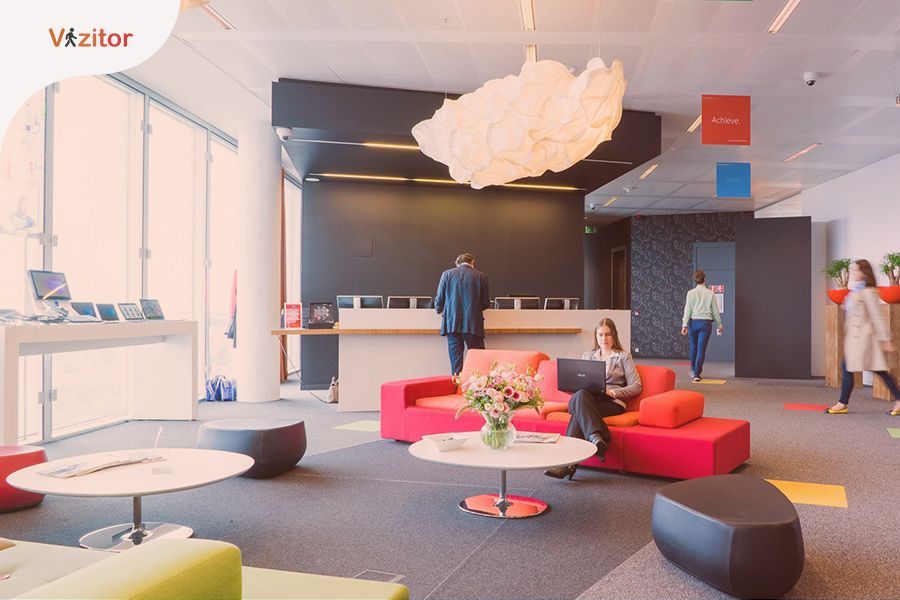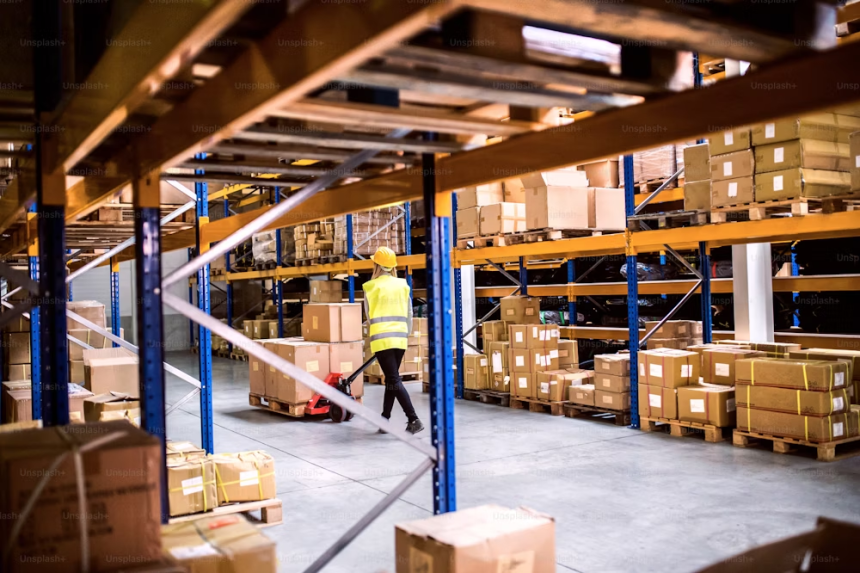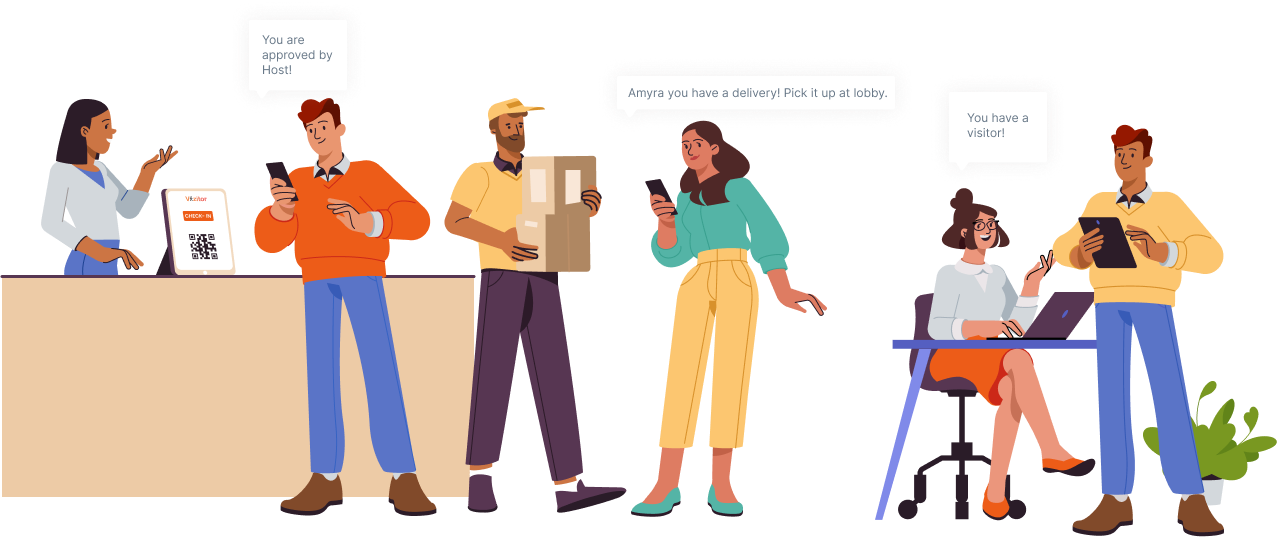Table of Content
Try Vizitor for Free!

Fri, Mar 14, 2025
Read in 12 minutes
Commercial buildings are high-traffic environments that must balance accessibility with security. Unauthorized access remains one of the most significant challenges, often due to ineffective visitor management. Weak visitor screening or verification increases risks such as theft, vandalism, and cyber threats, leaving businesses vulnerable to security breaches.
To mitigate these risks, businesses must implement robust security solutions that safeguard both physical assets and confidential business data. Advanced security measures such as access control systems, AI-powered surveillance, and digital visitor tracking are essential for maintaining a secure environment for employees and visitors.
Security Needs Across Industries
The security requirements of commercial buildings vary depending on their function. Different industries, such as airports, retail stores, industrial facilities, financial institutions, schools, medical centers, and business complexes, have unique security challenges. Each requires a multi-layered security approach, integrating both physical and digital safety measures to address potential threats effectively.
Digital Solutions for Enhanced Security
Digital Visitor Management Systems are transforming how businesses manage security in commercial buildings. These systems offer several key benefits, including:
- Streamlined visitor screening and verification
- Real-time tracking of visitor movement
- Enhanced access control for restricted areas
- Improved emergency response coordination
- Reduced security risks through automation
Mitigating Threats with Digital Tools
In this blog, we’ll explore the top security threats commercial buildings face and how businesses can use Digital Visitor Management Systems to effectively mitigate these risks. By adopting AI-driven security solutions, access control integration, and smart surveillance technologies, businesses can create a safer and more secure environment for employees and visitors.

Why is it vital to secure our commercial buildings?
The security of commercial buildings today is an important issue that requires careful consideration and planning. Commercial buildings such as Offices and Schools used to serve a constant inflow of visitors into their premises. These that these buildings must have robust and reliable technology for soothing their identification process to prevent entry of any intruder or offender in their premises.
1. Protecting commercial assets
Commercial buildings often contain valuable assets, including inventory, equipment, and confidential data. A strong security system can help prevent theft, vandalism, and other types of damage to these assets.
2. Ensuring building security
Many industries have specific security requirements that must be met to comply with regulations. For example, healthcare facilities must ensure patient privacy and protect medical records.
3. Comply with regulations
Many industries have specific security requirements that must be met to comply with regulations. For example, healthcare facilities must ensure patient privacy and protect medical records.
4. Safety concerns
Visitors and guests visiting your commercial buildings may also be concerned about their safety while visiting a commercial building, particularly if the building has a high volume of foot traffic. They may also face inconvenience when they have to fill out lengthy forms or provide excessive amounts of information, or be subjected to overly strict security protocols that make it difficult to move around the building freely.
Overall, commercial building security is an important investment that can help protect a business’s assets, people, and reputation. When it comes to commercial building security, you need solutions that will help your property managers, security staff, and administrators to maximize their productivity.
Top Security Threats Commercial Buildings face
Commercial buildings, big and small, are all susceptible to various security threats. However, they can have devastating effects on a building and its employees

So, it is vital to know about these common physical and cyber security threats for adequate protection of premises from them.
What is a Security Threat?
A security threat refers to any potential danger or risk to the security of a person, organization, or property. Security threats can come from various sources, such as natural disasters, criminal activities, cyber-attacks, terrorism, or even human error. The impact of a security threat can range from minor disruptions to severe consequences, including physical harm, financial losses, and reputational damage. Therefore, it’s essential to identify and address potential security threats promptly to protect against them and minimize the potential damage they can cause.
There are many security threats that commercial buildings are facing today. Some of the top ones are
1. Burglary and theft
Burglary and theft are significant security concerns for commercial buildings, which can lead to substantial financial losses and property damage. Commercial buildings, such as offices, retail stores, and warehouses, are often targeted by burglars because they contain valuable assets, goods, and cash. Some common methods of burglary and theft in commercial buildings include:
Breaking: Burglars may break windows or doors to gain access to a building.
Smashing and grabbing: Burglars may smash windows or doors to quickly grab valuable items and leave.
Cybercrime: Cyber attacks such as hacking, phishing, and ransomware can compromise the security of the building’s computer systems and data.
By implementing robust security measures, commercial building owners and managers can better protect their property and minimize the risk of burglary and theft.
2. Vandalism
Vandalism is a serious security threat to commercial buildings that can cause property damage, disrupt business operations, and negatively impact the building’s reputation. Vandalism in commercial buildings can take various forms, including graffiti, broken windows, damaged equipment, and defaced property.
3. Unauthorized access
Unauthorized access is a serious security threat to commercial buildings that can result in theft, property damage, or harm to individuals. Unauthorized access occurs when someone gains access to a building, area, or information without proper authorization. Unauthorized access to buildings can occur through various means, including lock-picking, unauthorized key duplication, or tailgating. Employees, contractors, and other insiders with access to a building can pose a security threat. This includes theft, sabotage, and unauthorized access to sensitive information.
4. Terrorism
Buildings can be targeted by terrorists seeking to cause harm, destruction, and chaos. Terrorists often target commercial buildings because they contain large numbers of people, and critical infrastructure, and symbolize economic and political power. Some common methods of terrorism in commercial buildings include:
Bombings: Terrorists may use explosives to cause property damage and harm to individuals.
Shootings: Terrorists may use firearms to cause harm to individuals in or around the building.
Cyber attacks: Terrorists may use cyber attacks to disrupt business operations and cause financial losses.
5. Cybersecurity threats
With the increasing reliance on technology, commercial buildings are becoming more vulnerable to cyber-attacks, including hacking, phishing, and malware.
6. Natural disasters
Natural disasters such as hurricanes, earthquakes, and fires can pose a significant threat to commercial buildings. Adequate preparation, such as installing fire suppression systems and emergency power generators, can help mitigate the risks.
Best Practices for Reducing Security Threats in Commercial Buildings
By implementing various security measures, commercial building owners and managers can reduce the risk of security threats, protect their assets, and provide a safe and secure environment for employees and visitors. These threats can be mitigated by using various methods
1. Access Control Systems
Implement an access control system that requires employees and visitors to scan a key card or enter a code to gain access to the building. Limit access to sensitive areas and ensure that only authorized personnel can access them.
2. Adequate Lighting
Ensure that the building is well-lit both inside and outside, particularly in areas with poor visibility or high risk of theft.
3. Secure Doors and Windows
Ensure that all doors and windows are properly secured with high-quality locks, and install window bars or shutters where necessary.
4. Risk Assessment
Conduct a risk assessment to identify potential security threats and vulnerabilities in the building. This will help prioritize security measures that need to be implemented.
5. Visitor Management
Implement a Visitor management system that requires visitors to provide identification and sign in before entering the building. Vizitor is one of the best visitor management solutions providing various key features to streamline various tasks among premises while improving efficiency and productivity levels.
6. Emergency Preparedness
Develop an emergency preparedness plan to respond to security threats such as fires, natural disasters, and terrorist attacks.
How does our Visitor Management System- Vizitor help to mitigate security threats?
Implementing a digital visitor management system can help mitigate security threats in commercial buildings. Visitor management systems can help mitigate security threats in commercial buildings by providing a way to control and track visitor access.
Vizitor is a visitor management system that can help mitigate security threats in buildings by providing a secure and efficient way to manage visitor access. Some of the key features of Vizitor that can help enhance building security include:
1. Pre-registration and pre-approval:
Vizitor allows visitors to pre-register and be pre-approved by the host before they arrive. This helps to streamline the check-in process and ensure that only authorized visitors are allowed entry into the building.
2. Customizable visitor badges:
Vizitor can print custom visitor badges that include the visitor’s name, photo, and purpose of their visit. This helps to easily identify visitors and track their movements throughout the building.
3. Automatic alerts:
Vizitor can send automatic alerts to hosts when their visitors arrive, check-in, and check out. This helps to ensure that hosts are aware of their visitors’ movements and can monitor their activities while in the building.
4. Access control integration:
Vizitor can integrate with access control systems to automatically grant or deny access to visitors based on their pre-approval status. This helps to prevent unauthorized visitors from entering restricted areas of the building.
5. Evacuation management:
Vizitor can assist with building evacuations by quickly identifying and locating visitors in the building, providing evacuation instructions, and generating reports of visitor status during an emergency of fire, earthquake, etc.
6. Visitor Gate Pass system:
A Visitor Gate pass is issued to the visitor when he/she arrives at the entry gate capturing the details of the visitor for identification purposes. It restricts access to specific areas within the premises to support the security system of the establishment.
7. Visitor Identification:
The system captures visitor facial images and digital signatures allows to printing professional visitor badges with the company’s logo and helps employees to easily identify the visitors when they meet.
How Employee Training Enhances Commercial Building Security
While advanced security systems like CCTV, access control, and visitor management play a vital role in safeguarding commercial buildings, employee awareness and training are equally important. A well-trained workforce can serve as the first line of defense against security threats.
Why Employee Training is Essential for Security
- Recognizing Suspicious Behavior – Employees can identify potential threats like unauthorized visitors, suspicious packages, or unusual activity.
- Preventing Cybersecurity Breaches – Training helps employees recognize phishing emails, social engineering attacks, and unauthorized data access attempts.
- Enhancing Emergency Response – Staff members should know how to respond to fire alarms, active threats, or evacuation procedures.
- Reducing Internal Security Risks – Insider threats from disgruntled employees or unauthorized access attempts can be minimized with proper awareness.
Key Security Training Programs for Employees
✔ Access Control Training – Employees should understand security badge usage, entry protocols, and restricted area policies.
✔ Cybersecurity Awareness – Conduct regular training on password protection, phishing detection, and data security best practices.
✔ Incident Reporting Procedures – Ensure staff knows how to report suspicious behavior or security incidents promptly.
✔ Fire & Evacuation Drills – Conduct routine drills to prepare employees for emergency situations.
✔ Handling Visitors & Deliveries – Train front desk personnel on how to verify visitors, check IDs, and report unverified deliveries.
Best Practices for Ongoing Security Training
- Regular Training Sessions – Security awareness should be reinforced through periodic workshops and online courses.
- Simulation Exercises – Conduct drills for fire safety, cyberattacks, and active threat scenarios.
- Access to Security Policies – Employees should have access to written security protocols and emergency response plans.
- Collaboration with Security Teams – Encourage communication between employees and security personnel to report concerns.
How Employee Training Reduces Security Risks
Studies show that human error is responsible for over 85% of security breaches. Regular training ensures that employees:
✔ Understand and follow company security protocols.
✔ Can identify potential threats before they escalate.
✔ Take quick action in emergency situations.
Fact: Companies that implement structured security training programs reduce security incidents by up to 70%.
FAQs
1. What are the biggest security threats to commercial buildings?
The top security threats to commercial buildings include unauthorized access, theft, vandalism, cybersecurity breaches, terrorism, and natural disasters. Implementing access control, CCTV surveillance, and visitor management systems can mitigate these risks.
2. How can businesses prevent unauthorized access?
Businesses can prevent unauthorized access by using biometric entry, smart keycards, access control systems, and real-time visitor tracking. Visitor Management Systems (VMS) ensure only authorized individuals enter restricted areas.
3. Why is visitor management important for building security?
A Visitor Management System (VMS) helps track, screen, and monitor visitors in real time. It enhances security by preventing unauthorized entry, improving emergency response, and ensuring compliance with security policies.
4. What is the role of cybersecurity in commercial building security?
Cybersecurity protects commercial buildings from hacking, phishing, malware, and data breaches. Businesses must implement firewalls, encryption, and employee cybersecurity training to safeguard sensitive data.
5. How does AI improve security in commercial buildings?
AI enhances security by using facial recognition, anomaly detection, and predictive analytics to identify threats before they occur. AI-powered CCTV cameras and access control systems improve security efficiency.
6. What security measures should every commercial building have?
Every commercial building should have:
- Access Control Systems (biometric authentication, keycard entry)
- CCTV Surveillance (real-time monitoring, AI detection)
- Visitor Management System (digital check-ins, pre-registration)
- Cybersecurity Protection (firewalls, encryption, anti-phishing training)
- Emergency Response Plan (evacuation procedures, fire alarms)
7. How often should businesses conduct security audits?
Businesses should conduct security audits at least twice a year to assess vulnerabilities, update security protocols, and ensure compliance with safety regulations.
8. How can businesses prepare for security emergencies?
Businesses can prepare for emergencies by:
- Conducting regular fire drills and lockdown exercises
- Installing emergency alert systems and panic buttons
- Ensuring visitor tracking for efficient evacuation
- Training employees on incident response procedures
9. What are the benefits of Visitor Management System?
Visitor Management System enhances security by:
- Automating visitor screening and approvals
- Integrating with access control systems for restricted entry
- Providing real-time visitor tracking for improved security
- Sending instant security alerts to prevent unauthorized access
10. How can lighting improve building security?
Proper lighting reduces security risks by eliminating dark areas where intruders can hide. Motion-activated lighting and well-lit entry points deter crime and improve surveillance visibility.
Final Thoughts
A proactive security strategy is crucial for safeguarding commercial properties, employees, and sensitive business data. From access control systems to AI-powered visitor management, integrating modern security technologies can drastically reduce risks.
Investing in real-time visitor tracking, biometric authentication, and AI surveillance can provide long-term security benefits. For businesses looking to upgrade their security strategy, Vizitor’s Visitor Management System offers comprehensive protection, visitor tracking, and seamless security integration.
Start protecting your commercial property today – schedule a free demo!










